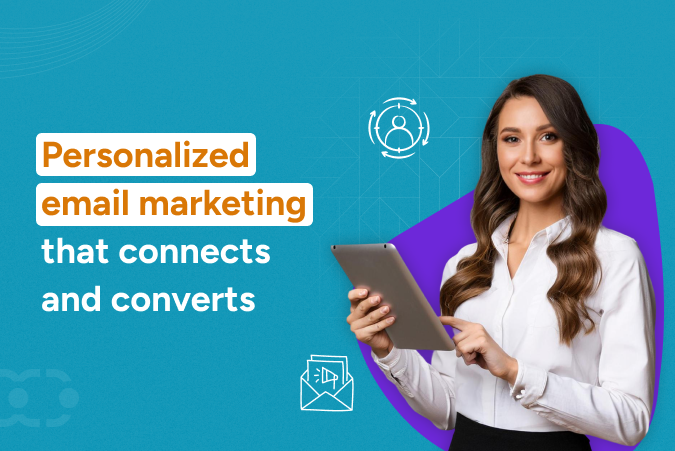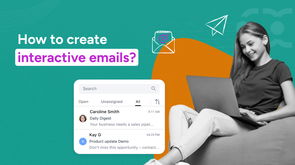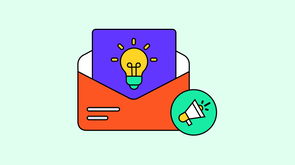Generic mass emails rarely survive today’s inbox. Customers now expect brands to address them as individuals, not as names on a list.
That’s where personalized email marketing transforms casual communication into meaningful connection.
Well, before moving forward, let me tell you that:
- Personalized emails deliver up to 6x higher transaction rates than non-personalized ones.
- Brands that personalize subject lines can see 26% higher open rates.
- AI-driven personalization is projected to influence over 60% of email campaigns by 2025.
This guide explores how personalization can reshape your email marketing. We’ll break down strategies, techniques, examples, and tools you can use to create campaigns that connect with every subscriber on a personal level.
What is email personalization?
Email personalization is more than adding a first name in the subject line. It’s the practice of tailoring email marketing campaigns to match the preferences, behavior, and needs of each recipient.
Email marketing personalization encompasses a range of strategies and techniques that go beyond basic customization to deliver highly relevant and engaging content.
By leveraging customer data such as browsing history, purchase history, and subscriber data, brands create personalized emails that resonate at a personal level.
At its core, personalization in email marketing is about sending relevant content to the right audience at the right time.
This could mean personalized subject lines that spark curiosity, dynamic content that changes based on customer segmentation, or targeted emails triggered by specific actions.
Modern email marketing platforms make this possible through automation, personalization tags, and analytics.
An email service provider enables advanced personalization by integrating customer data and supporting the use of personalization tags, making it easier to implement sophisticated email personalization strategies.
Hot take: 21 Brilliant email marketing examples to elevate your campaigns
The evolution of personalization in email campaigns
Personalization in email marketing has evolved from simple greetings to sophisticated AI-driven campaigns, reshaping how brands connect with their audience.
The evolution has included the ability to add personalization at every stage of the email campaign, enabling tailored content such as product recommendations and customized messaging with fallbacks for a seamless experience.
1. From generic emails to personalized content
In the early days, email marketing campaigns were the same for every subscriber. One subject line, one offer, and one generic call to action.
However, today’s audiences expect more than a template; they want personalized messages that speak directly to them.
Personalizing emails is crucial for engaging potential customers who have not yet made a purchase, as targeted communication can help convert their interest into action.
2. The shift to segmentation and targeted emails
The next phase was customer segmentation. Marketers began grouping subscribers by:
- Demographics (age, location, profession)
- Purchase history (repeat purchases, cart value)
- Engagement level (active vs inactive subscribers)
Segmenting audiences created more targeted emails that improved click-through rates and helped in customer relationship building.
Personalized email subject lines within segmented campaigns can further enhance engagement by capturing attention and increasing open rates.
3. The rise of dynamic content and automation
Now, personalization has moved beyond static segments into dynamic content and automated triggers. Emails adapt in real-time based on:
- Browsing history (recently viewed products)
- Purchase data (personalized product recommendations)
- Behavioral actions (cart abandonment, feedback requests)
This creates a personal touch at every stage of the customer journey, improving brand loyalty and customer satisfaction.
Also read: A detailed guide on email automation
4. AI-powered and predictive personalization
Today, advanced email marketing platforms integrate AI to:
- Predict send times for better engagement
- Suggest relevant content automatically
- Personalize offers based on emotional connection and behavioral signals
This shift toward AI in email marketing and personalization is setting the standard for future marketing strategies.
Make every email feel hand-written
Deliver smarter campaigns that connect, convert, and never get ignored with personalization powered by Salesmate.
Customer data foundations for personalization
Personalized email marketing relies on one essential element - quality data. Collecting as much data as possible from various sources, including website behavior, is essential for effective personalization.
The more accurate and organized your customer information is, the more relevant and engaging your campaigns become.
Analyzing customer behaviors, such as browsing and purchase patterns, allows for more tailored and impactful email content.
Why is data the backbone of personalization?
Effective personalized email marketing starts with valuable data. Without accurate subscriber data, even the most creative email campaigns will fail to engage.
A strong data strategy allows you to create personalized content, design dynamic emails, and deliver messages at the right point in the customer journey.
Types of data used in personalization
Data type | Description | Example uses in campaigns |
|---|
Zero-party data | Information customers share voluntarily | Email preferences, product interests |
First-party data | Data collected from customer interactions | Browsing history, purchase history, survey results |
Second-party data | Data shared from trusted partners | Industry affiliations, demographic insights |
Key data points for effective personalization
To create personalized emails that truly connect, marketers often collect:
- Name and location (for personalized subject lines)
- Engagement metrics (open rates, click-through rates)
- Behavioral triggers (cart abandonment, repeat purchases)
- Customer feedback requests (to tailor future email campaigns)
Helpful read: How to drive business growth with hyper personalization in CRM?
Practical techniques for effective email personalization
Personalization is most effective when applied across multiple elements of an email.
Marketers can utilize a range of email personalization techniques and strategies to tailor their email campaigns and individualize their emails for each recipient.
From the subject line to the body content and even the timing, each component can be tailored to create a personal connection that drives engagement.
1. Personalized subject lines
Your email subject line is the first impression in any campaign. Personalizing it can improve click-through rates and open rates significantly.
Examples of personalization in subject lines:
- Adding the subscriber’s name (“Sarah, your exclusive offer is inside”)
- Referencing purchase history (“Time to restock your favorite product, Michael”)
- Using behavior triggers (“Still thinking about that item in your cart, David?”)
2. Dynamic content
Dynamic content changes automatically based on customer segmentation or behavioral data, ensuring each subscriber sees relevant content.
Marketers can personalize emails by using personalization tags to dynamically insert recipient names, sales representative names, or other details, and add personalization elements such as tailored product recommendations or customized messaging to increase engagement.
Examples of dynamic personalization:
- Product recommendations based on browsing history
- Special discounts for repeat purchases
- Tailored updates for customers based on online shopping cart activity
3. Behavioral triggers
Trigger-based personalization ensures emails arrive at the right moment in the customer journey. Common triggers include:
- Cart abandonment emails to re-engage inactive subscribers
- Follow-up messages after a purchase or feedback request
- Reminder emails for renewals or special events
By leveraging these behavioral triggers, you can encourage customers to take profitable customer action, such as completing a purchase or making a repeat donation.
4. Personalization tags and imagery
Beyond names and locations, advanced personalization uses personalization tags and even personalized images to create an emotional connection.
- Insert customer-specific information in product updates
- Use personalized imagery to match interests or previous purchases
Pinpoint targeting through smarter segmentation
Segmentation transforms personalization from a broad idea into an actionable strategy.
The marketing team plays a crucial role in designing segmentation strategies and crafting marketing emails that resonate with each audience segment.
By dividing your audience into precise groups, you ensure that every email feels relevant, timely, and designed for the recipient.
Why does smarter segmentation matter?
Generic email blasts can feel disconnected from a subscriber’s needs.
Smarter segmentation allows email marketing campaigns to match each group’s preferences, driving higher click-through rates and more meaningful customer engagement.
Proven segmentation approaches
Segmentation is most effective when it goes beyond demographics. Powerful methods include:
- Behavior-based segmentation (actions like browsing history, purchase history)
- Lifecycle segmentation (new customers, loyal buyers, inactive subscribers)
- Engagement segmentation (active clickers vs low responders)
Crafting targeted messages for each group
Once your audience is segmented, personalized email campaigns can be crafted for each group.
Examples include:
- Special offers for VIP segments
- Re-engagement campaigns for inactive subscribers
- Tailored product suggestions based on recent browsing
How automation simplifies segmentation
With tools like Salesmate, segmentation is automated. The platform tracks customer behavior in real time and updates lists dynamically, ensuring personalized messages reach the right people at the right point in their customer journey.
Best practices and optimization tactics
Even with advanced personalization techniques, success depends on consistently applying the best email marketing practices.
Optimizing for a higher click-through rate is a key goal of personalized email marketing, as it reflects how effectively your content engages subscribers and drives them to take action.
These tactics ensure your campaigns remain effective, engaging, and aligned with customer expectations.
Additionally, adhering to privacy standards like GDPR and CAN-SPAM helps build trust.
Integrating social media engagement data can further enhance the relevance and effectiveness of your email campaigns by aligning messages with customer behaviors across platforms.
1. Start with clear objectives
Every personalized email marketing strategy should begin with a clear purpose.
Defining what success looks like, whether it’s higher click-through rates, improved customer engagement, or increased repeat purchases, ensures every element of the campaign works toward measurable goals.
Without clear objectives, even the most advanced personalization can lose direction.
2. Test and refine regularly
No personalization approach should remain static. A/B testing helps uncover what truly resonates with your audience.
Testing different personalized subject lines, variations of dynamic content, and optimized send times offers insight into performance trends.
3. Personalize timing and frequency
Timing is critical in email personalization. Sending too many emails can cause disengagement, while sending too few can make a brand fade from subscribers’ minds.
AI email personalization tools can analyze subscriber behavior to predict the optimal send times and ideal frequency for each segment. This ensures messages arrive at the moment when they are most likely to spark engagement.
4. Avoid over-personalization
While personalization creates stronger customer relationships, it must be done thoughtfully. Overly detailed or intrusive use of customer data can make recipients uncomfortable.
Maintaining a customer-centric approach and adhering to privacy standards like GDPR and CAN-SPAM helps build trust.
When personalization feels natural and respectful, it enhances brand loyalty rather than risking it.
Real-world examples and case studies
Personalized email marketing has been mastered by some of the world’s biggest brands. These examples show how thoughtful personalization can drive engagement, conversions, and customer loyalty.
Amazon – Product recommendations that feel timely
Amazon has built its reputation on data-driven personalization. By analyzing browsing history, purchase history, and abandoned carts, Amazon delivers emails that highlight products a customer is most likely to buy.
These recommendations are often paired with dynamic elements, such as real-time availability or price updates, making each message timely and relevant.
Netflix – Content suggestions that boost engagement
Netflix uses customer behavior and viewing history to personalize email updates about new releases. Instead of sending a generic list, each subscriber receives tailored suggestions that reflect their past preferences.
This not only increases open rates but also strengthens customer relationships by showing users content that aligns with their interests.
Spotify – Wrapped campaigns that create emotional connection
Spotify’s annual “Wrapped” campaign is a standout example of hyper-personalized email marketing. It compiles a listener’s most-streamed songs, artists, and genres, presenting the data in an engaging, shareable format.
This approach taps into nostalgia, creating an emotional connection that sparks social sharing and deepens brand loyalty.
How Salesmate is the best tool for email personalization
An effective personalized email marketing strategy needs more than creativity. It requires a platform that manages customer data, automates personalization, and delivers relevant messages at scale. Maintaining a strong customer relationship is central to Salesmate's approach to email personalization.
Salesmate brings these capabilities together, offering tools that help businesses create impactful, targeted campaigns.
- Contact management: Organize and maintain detailed subscriber data, track preferences, and segment audiences for targeted email campaigns that feel personal. Salesmate enables personalized outreach from a sales representative to build trust and continuity with each customer.
- AI employee: Use AI-powered assistance to craft personalized subject lines, recommend relevant content, and optimize send times for higher engagement.
- Call transcription: Convert every sales or support conversation into searchable text, providing deeper customer insights to create follow-up emails that are timely and relevant.
- Workflow automation: Automate personalized email sequences triggered by behaviors such as cart abandonment, onboarding milestones, or inactivity, ensuring timely communication.
- Lead scoring: Identify high-value prospects by tracking engagement metrics, ensuring that the most promising leads receive highly personalized outreach.
- Analytics & reporting: Monitor click-through rates, engagement, and conversions to refine personalization strategies and continuously improve results.
- Integrations: Connect with other marketing and sales tools to streamline data sharing, ensuring consistent personalization across multiple digital marketing channels.
Ready to make every email feel one-on-one?
Ditch the generic. Start delivering personalized emails that actually get replies with zero hassle.
Final words
Personalized email marketing has evolved into one of the most effective ways to connect with customers on a deeper, more meaningful level.
From carefully crafted subject lines to data-driven segmentation and AI-powered automation, every step brings your brand closer to meaningful engagement.
The strategies, techniques, and tools outlined in this guide show that personalization is no longer an optional enhancement; it is the standard that separates relevant campaigns from the ones that get ignored.
By aligning creativity with technology, businesses can transform their email communications into timely, valuable experiences for every recipient.
Choosing the right platform makes this transformation seamless. With its blend of intelligent automation, robust data management, and advanced personalization capabilities, Salesmate empowers teams to deliver campaigns that not only reach inboxes but also resonate.
Frequently asked questions
1. What is personalization in email marketing?
Email personalization is the process of tailoring email content based on subscriber data such as name, location, browsing history, or purchase behavior. It helps create relevant messages that resonate with each recipient, improving engagement and conversions.
2. How does email personalization improve open rates?
Personalized emails often feature relevant subject lines, targeted content, and optimized send times. These elements make messages more appealing, which encourages subscribers to open and interact with them.
3. What data is important for email personalization?
Key data points include subscriber preferences, purchase history, browsing activity, and engagement behavior. This information helps craft targeted campaigns that match the recipient’s interests and stage in the customer journey.
4. What are some best practices for personalized email marketing?
Best practices include setting clear campaign objectives, using audience segmentation, testing subject lines and send times, and avoiding over-personalization to maintain trust.
5. Which tools are best for email personalization?
The best tools combine contact management, automation, segmentation, AI personalization, and analytics. Platforms like Salesmate streamline these features, making it easier to execute personalized email campaigns at scale.





![Follow up email template 15 Best follow up email templates [With best examples]](/mm-images/follow-up-email-template-iquligf6.webp?width=295)

Key takeaways
Generic mass emails rarely survive today’s inbox. Customers now expect brands to address them as individuals, not as names on a list.
That’s where personalized email marketing transforms casual communication into meaningful connection.
Well, before moving forward, let me tell you that:
This guide explores how personalization can reshape your email marketing. We’ll break down strategies, techniques, examples, and tools you can use to create campaigns that connect with every subscriber on a personal level.
What is email personalization?
Email personalization is more than adding a first name in the subject line. It’s the practice of tailoring email marketing campaigns to match the preferences, behavior, and needs of each recipient.
Email marketing personalization encompasses a range of strategies and techniques that go beyond basic customization to deliver highly relevant and engaging content.
By leveraging customer data such as browsing history, purchase history, and subscriber data, brands create personalized emails that resonate at a personal level.
At its core, personalization in email marketing is about sending relevant content to the right audience at the right time.
This could mean personalized subject lines that spark curiosity, dynamic content that changes based on customer segmentation, or targeted emails triggered by specific actions.
Modern email marketing platforms make this possible through automation, personalization tags, and analytics.
An email service provider enables advanced personalization by integrating customer data and supporting the use of personalization tags, making it easier to implement sophisticated email personalization strategies.
The evolution of personalization in email campaigns
Personalization in email marketing has evolved from simple greetings to sophisticated AI-driven campaigns, reshaping how brands connect with their audience.
The evolution has included the ability to add personalization at every stage of the email campaign, enabling tailored content such as product recommendations and customized messaging with fallbacks for a seamless experience.
1. From generic emails to personalized content
In the early days, email marketing campaigns were the same for every subscriber. One subject line, one offer, and one generic call to action.
However, today’s audiences expect more than a template; they want personalized messages that speak directly to them.
Personalizing emails is crucial for engaging potential customers who have not yet made a purchase, as targeted communication can help convert their interest into action.
2. The shift to segmentation and targeted emails
The next phase was customer segmentation. Marketers began grouping subscribers by:
Segmenting audiences created more targeted emails that improved click-through rates and helped in customer relationship building.
Personalized email subject lines within segmented campaigns can further enhance engagement by capturing attention and increasing open rates.
3. The rise of dynamic content and automation
Now, personalization has moved beyond static segments into dynamic content and automated triggers. Emails adapt in real-time based on:
This creates a personal touch at every stage of the customer journey, improving brand loyalty and customer satisfaction.
4. AI-powered and predictive personalization
Today, advanced email marketing platforms integrate AI to:
This shift toward AI in email marketing and personalization is setting the standard for future marketing strategies.
Make every email feel hand-written
Deliver smarter campaigns that connect, convert, and never get ignored with personalization powered by Salesmate.
Customer data foundations for personalization
Personalized email marketing relies on one essential element - quality data. Collecting as much data as possible from various sources, including website behavior, is essential for effective personalization.
The more accurate and organized your customer information is, the more relevant and engaging your campaigns become.
Analyzing customer behaviors, such as browsing and purchase patterns, allows for more tailored and impactful email content.
Why is data the backbone of personalization?
Effective personalized email marketing starts with valuable data. Without accurate subscriber data, even the most creative email campaigns will fail to engage.
A strong data strategy allows you to create personalized content, design dynamic emails, and deliver messages at the right point in the customer journey.
Types of data used in personalization
Data type
Description
Example uses in campaigns
Zero-party data
Information customers share voluntarily
Email preferences, product interests
First-party data
Data collected from customer interactions
Browsing history, purchase history, survey results
Second-party data
Data shared from trusted partners
Industry affiliations, demographic insights
Key data points for effective personalization
To create personalized emails that truly connect, marketers often collect:
Practical techniques for effective email personalization
Personalization is most effective when applied across multiple elements of an email.
Marketers can utilize a range of email personalization techniques and strategies to tailor their email campaigns and individualize their emails for each recipient.
From the subject line to the body content and even the timing, each component can be tailored to create a personal connection that drives engagement.
1. Personalized subject lines
Your email subject line is the first impression in any campaign. Personalizing it can improve click-through rates and open rates significantly.
Examples of personalization in subject lines:
2. Dynamic content
Dynamic content changes automatically based on customer segmentation or behavioral data, ensuring each subscriber sees relevant content.
Marketers can personalize emails by using personalization tags to dynamically insert recipient names, sales representative names, or other details, and add personalization elements such as tailored product recommendations or customized messaging to increase engagement.
Examples of dynamic personalization:
3. Behavioral triggers
Trigger-based personalization ensures emails arrive at the right moment in the customer journey. Common triggers include:
By leveraging these behavioral triggers, you can encourage customers to take profitable customer action, such as completing a purchase or making a repeat donation.
4. Personalization tags and imagery
Beyond names and locations, advanced personalization uses personalization tags and even personalized images to create an emotional connection.
Pinpoint targeting through smarter segmentation
Segmentation transforms personalization from a broad idea into an actionable strategy.
The marketing team plays a crucial role in designing segmentation strategies and crafting marketing emails that resonate with each audience segment.
By dividing your audience into precise groups, you ensure that every email feels relevant, timely, and designed for the recipient.
Why does smarter segmentation matter?
Generic email blasts can feel disconnected from a subscriber’s needs.
Smarter segmentation allows email marketing campaigns to match each group’s preferences, driving higher click-through rates and more meaningful customer engagement.
Proven segmentation approaches
Segmentation is most effective when it goes beyond demographics. Powerful methods include:
Crafting targeted messages for each group
Once your audience is segmented, personalized email campaigns can be crafted for each group.
Examples include:
How automation simplifies segmentation
With tools like Salesmate, segmentation is automated. The platform tracks customer behavior in real time and updates lists dynamically, ensuring personalized messages reach the right people at the right point in their customer journey.
Best practices and optimization tactics
Even with advanced personalization techniques, success depends on consistently applying the best email marketing practices.
Optimizing for a higher click-through rate is a key goal of personalized email marketing, as it reflects how effectively your content engages subscribers and drives them to take action.
These tactics ensure your campaigns remain effective, engaging, and aligned with customer expectations.
Additionally, adhering to privacy standards like GDPR and CAN-SPAM helps build trust.
Integrating social media engagement data can further enhance the relevance and effectiveness of your email campaigns by aligning messages with customer behaviors across platforms.
1. Start with clear objectives
Every personalized email marketing strategy should begin with a clear purpose.
Defining what success looks like, whether it’s higher click-through rates, improved customer engagement, or increased repeat purchases, ensures every element of the campaign works toward measurable goals.
Without clear objectives, even the most advanced personalization can lose direction.
2. Test and refine regularly
No personalization approach should remain static. A/B testing helps uncover what truly resonates with your audience.
Testing different personalized subject lines, variations of dynamic content, and optimized send times offers insight into performance trends.
3. Personalize timing and frequency
Timing is critical in email personalization. Sending too many emails can cause disengagement, while sending too few can make a brand fade from subscribers’ minds.
AI email personalization tools can analyze subscriber behavior to predict the optimal send times and ideal frequency for each segment. This ensures messages arrive at the moment when they are most likely to spark engagement.
4. Avoid over-personalization
While personalization creates stronger customer relationships, it must be done thoughtfully. Overly detailed or intrusive use of customer data can make recipients uncomfortable.
Maintaining a customer-centric approach and adhering to privacy standards like GDPR and CAN-SPAM helps build trust.
When personalization feels natural and respectful, it enhances brand loyalty rather than risking it.
Real-world examples and case studies
Personalized email marketing has been mastered by some of the world’s biggest brands. These examples show how thoughtful personalization can drive engagement, conversions, and customer loyalty.
Amazon – Product recommendations that feel timely
Amazon has built its reputation on data-driven personalization. By analyzing browsing history, purchase history, and abandoned carts, Amazon delivers emails that highlight products a customer is most likely to buy.
These recommendations are often paired with dynamic elements, such as real-time availability or price updates, making each message timely and relevant.
Netflix – Content suggestions that boost engagement
Netflix uses customer behavior and viewing history to personalize email updates about new releases. Instead of sending a generic list, each subscriber receives tailored suggestions that reflect their past preferences.
This not only increases open rates but also strengthens customer relationships by showing users content that aligns with their interests.
Spotify – Wrapped campaigns that create emotional connection
Spotify’s annual “Wrapped” campaign is a standout example of hyper-personalized email marketing. It compiles a listener’s most-streamed songs, artists, and genres, presenting the data in an engaging, shareable format.
This approach taps into nostalgia, creating an emotional connection that sparks social sharing and deepens brand loyalty.
How Salesmate is the best tool for email personalization
An effective personalized email marketing strategy needs more than creativity. It requires a platform that manages customer data, automates personalization, and delivers relevant messages at scale. Maintaining a strong customer relationship is central to Salesmate's approach to email personalization.
Salesmate brings these capabilities together, offering tools that help businesses create impactful, targeted campaigns.
Ready to make every email feel one-on-one?
Ditch the generic. Start delivering personalized emails that actually get replies with zero hassle.
Final words
Personalized email marketing has evolved into one of the most effective ways to connect with customers on a deeper, more meaningful level.
From carefully crafted subject lines to data-driven segmentation and AI-powered automation, every step brings your brand closer to meaningful engagement.
The strategies, techniques, and tools outlined in this guide show that personalization is no longer an optional enhancement; it is the standard that separates relevant campaigns from the ones that get ignored.
By aligning creativity with technology, businesses can transform their email communications into timely, valuable experiences for every recipient.
Choosing the right platform makes this transformation seamless. With its blend of intelligent automation, robust data management, and advanced personalization capabilities, Salesmate empowers teams to deliver campaigns that not only reach inboxes but also resonate.
Frequently asked questions
1. What is personalization in email marketing?
Email personalization is the process of tailoring email content based on subscriber data such as name, location, browsing history, or purchase behavior. It helps create relevant messages that resonate with each recipient, improving engagement and conversions.
2. How does email personalization improve open rates?
Personalized emails often feature relevant subject lines, targeted content, and optimized send times. These elements make messages more appealing, which encourages subscribers to open and interact with them.
3. What data is important for email personalization?
Key data points include subscriber preferences, purchase history, browsing activity, and engagement behavior. This information helps craft targeted campaigns that match the recipient’s interests and stage in the customer journey.
4. What are some best practices for personalized email marketing?
Best practices include setting clear campaign objectives, using audience segmentation, testing subject lines and send times, and avoiding over-personalization to maintain trust.
5. Which tools are best for email personalization?
The best tools combine contact management, automation, segmentation, AI personalization, and analytics. Platforms like Salesmate streamline these features, making it easier to execute personalized email campaigns at scale.
Yasir Ahmad
Content EditorYasir Ahmad is the content editor at Salesmate who adds the finishing touch to the blogs you enjoy, turning CRM talk into stories you’ll actually want to read. He’s all about making complex stuff simple and a little fun too. When he’s not fine-tuning words, you can find him diving into the world of literature, always on the hunt for the next great story.